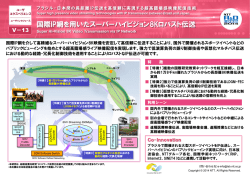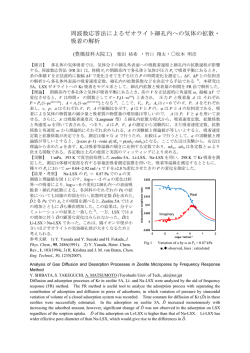
イオン液体|水界面における 界面活性イオンの吸着特性:油水界面との比較
イオン液体|水界面における 界面活性イオンの吸着特性:油水界面との比較 (京大院工) ○西 直哉・南 栄次・作花哲夫 【緒言】イオン液体(IL)はイオンのみから構成される液体の塩であり、水とも有機溶媒とも異 なる「第三の溶媒」として、様々な分野での応用が期待されている。特に疎水性 IL と水(W) は混じり合わずに液液二相系となり、溶媒抽出、液体クロマトグラフィー、液液二相合成、 電気化学デバイスなどの分野で盛んに研究されている。 IL-W 二相系における溶質イオンの分配特性や IL|W 界面への吸着特性はこの新規液液二相 系を設計する上で基本的なパラメーターとなる。これまでに分配特性に関しては多くの報告 がなされてきたのに対して、吸着特性を定量的に評価している報告はなかった。我々は最近 IL|W 界面への界面活性イオンの吸着特性およびその相間電位差依存性を定量的に評価し報告 した[1]。本研究では、それらを油水界面の場合[2,3]と比較した。 【実験】疎水性 IL には trioctylmethylammonium bis(nonafluorobutanesulfonyl)amide ([TOMA+] [C4C4N−])を、界面活性イオンには dodecyl sulfate (C12SO4−)を用いた。W 相中における IL 懸滴 の輪郭を解析して IL|W 界面の界面張力(γ)を測定した。相間電位差を 4 電極式のポテンシオス タットで外部制御した。 【結果と考察】IL|W 界面の界面張力γは W 相に Na+C12SO4−を添加するにつれて減少し、C12SO4− の IL|W 界面への吸着が確認された。γの減少は、C12SO4−が IL に分配する電位でも、W に分配する 電位でも、同程度に見られた。これは油水界面において C12SO4−[3]や他の一般的な界面活性イオン [2,3]で見られる、W に分配する電位でのみγが大きく減少する傾向、と異なる。 γの W 相 C12SO4−濃度依存性の解析[2]から、C12SO4−の W 相からの吸着の標準 Gibbs エネル ギーΔ W, を求め、ニトロベンゼン(NB)|W 界面の場合[3]と比較した。C12SO4−が IL(orNB) に分配する電位では NB|W 界面よりも IL|W 界面の方が 3 kJ/mol 程度Δ W, が低い、つまり界面 活性能が高い。一方、C12SO4−が W に分配する電位ではΔ W, は同程度であった。Δ W, の電位依 存性から、吸着時における界面活性イオンの帯電部位の位置を見積もると、NB|W 界面では NB (orW)に分配する電位で界面の NB 側(orW 側)に帯電部位が存在するのに対し、IL|W 界面では、 どの電位でも帯電部位は界面の IL 側に存在する。IL|W 界面では界面活性イオンの帯電部位を IL 構成イオンが取り囲んで安定化していると考えられる。他の 2 種類の疎水性 IL でも同様の結果が得 られ、上記の傾向は油水界面と異なる IL|W 界面の特異性と考えられる。 [1] E. Minami and N. Nishi, Rev. Polarogr, 58(2012)213 (meeting abstract). [2] Y. Kitazumi and T. Kakiuchi, Langmuir, 25(2009)8062. [3] 二子石 師、京都大学工学部工業化学科卒業論文、2011. Adsorption Characteristics of Surface-Active Ions at Ionic Liquid|Water Interface: Comparison with the Case at Oil|Water Interface N. NISHI, E. MINAMI, T. SAKKA (Kyoto Univ., [email protected]) Adsorption characteristics of surface-active ion at the ionic liquid (IL)|water (W) interface have been compared with those at the oil|W interface. The interfacial tension (γ) at the IL|W interface decreases with increasing the concentration of dodecyl sulfate ion in W. The extent of the γ decrease is similar for the two phase-boundary-potential regions: the potentials at which the ions are partitioned in W and those in IL. This tendency is in contrast to that observed at the nitrobenzene (NB)|W and other oil|W interface, where the ions are adsorbed especially when the ions are partitioned in W. The evaluation of the standard Gibbs energy for adsorption from W and the analysis of its phase-boundary-potential dependence suggest that the charged moiety of the ions adsorbed at IL|W interface is located at the IL side of the interface regardless of the phase-boundary potential, stabilized by the surrounding IL-constituting ions.
© Copyright 2026


